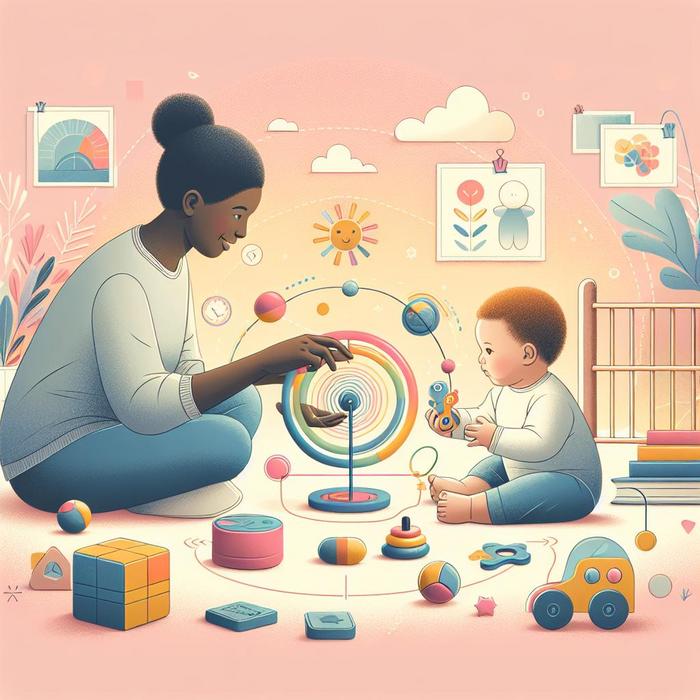Igniting Curiosity: Encouraging Infant Learning in the Early Years
The Importance of Encouraging Curiosity
Curiosity is the driving force behind learning and development throughout a baby’s early years. By sparking curiosity in babies, we pave the way for robust brain development, crucial for their cognitive and emotional growth. This article will delve into practical strategies for encouraging infant learning and exploration. The aim is to empower parents to nurture their baby’s natural curiosity and instill a love for learning right from the start.
Creating a Stimulating Environment
- Introduce a variety of sensory experiences: Babies learn by exploring the world around them. Providing a range of textures, colors, sounds, and tastes can stimulate their senses and ignite their curiosity. Encourage your baby to explore and engage in sensory play, which can significantly enhance their learning experiences.
- Ensure a safe space for exploration: Your little explorer will learn best in a safe and secure environment. Make sure your home is baby-proofed, providing a haven for your child to explore independently without fear of injury.
- Equip with age-appropriate toys: Toys play a pivotal role in stimulating a baby’s intellect and imagination. Choose toys that are suitable for your child’s age and can help develop their motor skills, problem-solving abilities, and creative thinking.
Parental Involvement in Fostering Curiosity
While a stimulating environment plays a central role, the parent’s active involvement in their child’s learning journey is equally important. Here are a few ways you can actively stimulate curiosity and learning in your baby:
- Play together: Playtime is the best of times for learning. Engage in interactive games, read out storybooks, build blocks, or just simply play peekaboo. This not only strengthens your bond but also helps in encouraging infant learning.
- Incorporate learning into daily routines: Everyday activities, such as feeding, bathing, or dressing, offer numerous learning opportunities. For example, during bath time, you can introduce your baby to the concept of ‘big’ and ‘small’ or ‘full’ and ’empty’ using bath toys.
- Respond to their cues: Babies communicate their interest in various ways. It might be through a gaze, an excited kick, or a wide-eyed wonder. Responding to these cues by acknowledging their interest encourages them to explore and learn more.
- Promote independent exploration: As your baby grows, they begin to explore independently. It’s essential to recognize this change and promote independent learning by letting your baby lead their playtime. You can find more tips on encouraging independent exploration here.
Music and Learning
Research has shown that music can play a significant role in enhancing brain development and learning in babies. Soothing soundscapes can not only help calm your baby but also stimulate auditory development and learning. For more information on the benefits of music for your baby, visit here.
Encouraging infant learning is all about providing opportunities for exploration, stimulating their senses, and offering a safe space for independent play. May your baby’s curiosity bloom, fostering a lifelong love for learning!
Understanding Your Baby’s Learning Style
Just like adults, infants have their unique learning styles. It might be through visual engagement, auditory stimulation, or hands-on play. Understanding your baby’s preferred learning style can significantly enhance their overall learning experience. You can pick up on their style by observing how they interact with their environment. If your baby seems to get excited by sounds and music, it may mean they’re an auditory learner. If they’re visibly drawn to colorful objects or tend to observe their surroundings keenly, they possibly have a visual learning style.
Building Secure Attachments
An essential aspect of fostering curiosity is creating a secure attachment between you and your baby. This secure attachment creates a safe space from which your baby feels comfortable exploring their surroundings. As explained by Developmental Science, a secure attachment forms when parents consistently respond to their baby’s needs. This predictable response builds trust and confidence, encouraging the baby to explore and learn with the comfort of knowing support is always available when needed.
Art and Creative Exploration
Introducing art at a young age is beneficial for your child’s development. It enhances fine motor skills, encourages creative thinking, and offers a fun way to explore colors and shapes. Experiment with diverse forms of art, such as finger painting, collages, or clay modeling. Michigan State University Extension shares articulately on the importance of art for early childhood development.
Integrating Science-Based Learning Approach
It’s never too early to introduce the basics of science to your child. The Harvard Graduate School of Education’s Center on the Developing Child highlights the importance of this approach. According to their insights, simply fostering your child’s curiosity about the world around them is already a scientific temperament in the making. This bestows crucial cognitive abilities and instills a love for lifelong learning in them. Explore more on their insights here.
Exploring the Sense of Taste
When your baby starts consuming solid food, it’s a perfect occasion to nurture their curiosity. Introduce different types of food items varying in taste and texture to ignite their sense of taste. Explain the idea of ‘sweet’, ‘sour’, ‘bitter’, and ‘salty’ using practical examples. For instance, you can use fruits to explain ‘sweet’ and ‘sour’. More about exploring the sense of taste for toddlers can be found on Engineering Emily.
Your baby’s initial years are a delightful journey filled with exploration, learning, and growth. As parents, your role is to safely guide them, stimulating their senses, and fostering their natural curiosity. Here’s to a lifetime of learning!

